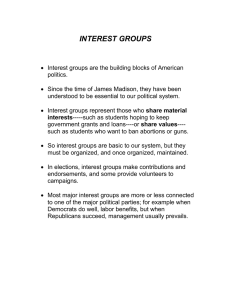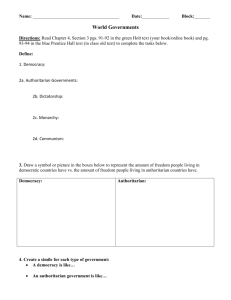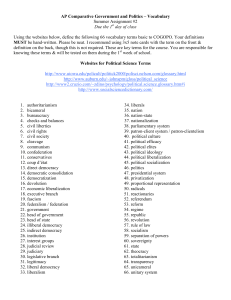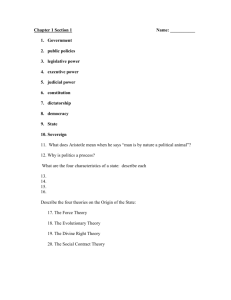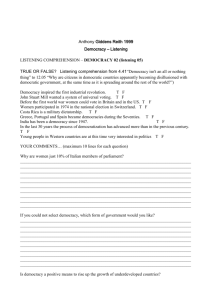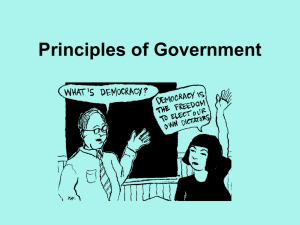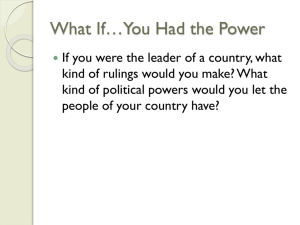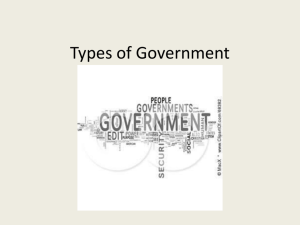Representation and the Political Process
advertisement
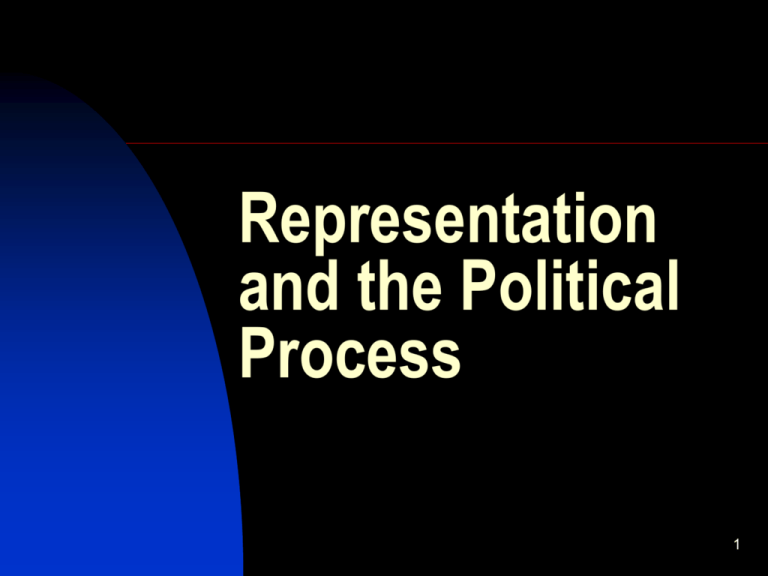
Representation and the Political Process 1 Democracy Direct (historically earlier form): citizens themselves govern Representative (modern) To which extent is it possible? Government by citizens’ representatives The main principles: The state is a separate entity above society The state derives its authority from citizen consent State officials have an autonomy from society, but are accountable to it 2 What is the meaning of representation? 1. Rulers are elected, granted authority to govern but may not necessarily do what citizens want: unfulfilled promises “painful but necessary” reforms 2. Rulers are not elected, but govern in such a way that citizens do feel that their interests are taken into account kindly kings, benevolent dictators seeking citizen support Obviously, electoral democracy is a better form of representation But major problems remain 3 For instance: washingtonpost.com: Big-Money Contributors Line Up for Inauguration 4 1. Electoral mechanisms: how well do they communicate society’s demands to the state 2. Channels of citizen influence on the government between elections – in the policy-making process 3. The contents of policy Some of these problems can be solved through improvements in the mechanisms of representation But there are strong arguments in favour of reinforcing representation with robust institutions of direct democracy 5 The political process The political process can be described as the flow of political power This flow never stops It has its own patterns, reproduced over and over again in a systematic way It moves through institutions, links, channels which connect society with the state 6 The Political Process Government Interest Groups Executive Political Parties Assembly Media Judiciary Demands Supports LAWS AND POLICIES INTERESTS Elections Social impact of laws and policies SOCIETY THE STATE 7 Some interests have more weight than others. Such differences are reflected in every part of the political process Some interests need the state more than others Different interests need the state for different things The flow of power has a dual nature Power flows in two directions: from society to the state from the state to society 8 Overall, the dominance of the society-to-state flow should be a sign of democracy: the government heeds societal demands But if one looks at the unequal distribution of power, the picture looks different Economically dominant classes exert dominant control over both flows of power The rise of economic inequality in society is a sign that the political process works primarily for those at the top, creating a DEMOCRATIC DEFICIT 9 Interest Groups and Interest Articulation The basic actor in the political process is the individual citizen The range of individual political impact From letters to MPs and newspapers To being a Bill Gates – or a Prime Minister’s close friend But most individuals can have any impact only by acting through interest groups – created to articulate (formulate and express) group interests In modern societies, they are numerous They vary in structure, goals, style, financing, support base 10 4 main types of interest groups* ANOMIC NONASSOCIATIONAL INSTITUTIONAL ASSOCIATIONAL -------------------------------*See Gabriel Almond, Bingham Powell et al., Comparative Politics Today, 8th edition, Longman, 2003, Chapter 4 11 ANOMIC GROUPS Spontaneous (more or less) formations which arise to respond to a specific issue, usually in a crisis – demonstrations, riots Not well-organized or sustained but may trigger off revolutions… Can be created by organized groups 12 NONASSOSIATIONAL GROUPS Like anomic groups, not well-organized Unlike anomic groups, are based on common identities, such as ethnicity, region, religion, occupation, etc. Can be very large (ethnic communities in Canada) – or very small (residents of a village) 13 INSTITUTIONAL GROUPS Formal groups created for the purpose of influencing government policy Mostly elite groups, are created by people possessing significant social power - businessmen, military officers, bureaucrats, politicians, the clergy Possess large resources – financial, organizational, etc. Often have direct channels of influence on policy 14 ASSOCIATIONAL GROUPS Created to represent on a sustained basis diverse social interests – trade unions, business sectors, ethnic, religious, civic groups, etc. They lobby, finance election campaigns, put out their message through the media A strong civil society is characterized by the existence of strong, well-organized non-elite associational groups which exert real influence on the political process 15 How interest groups act and interact 3 main interest group systems: Pluralist – free interplay between the groups Democratic corporatist – systematic, organized coordination, with involvement of government officials Controlled – in authoritarian states, have no freedom of action, closely controlled by ruling parties and bureaucracies (authoritarian corporatism) 16 Channels used to transmit demands Legal access channels: Personal connections Mass media Political parties Legislatures Government bureaucracies Protest demonstrations, strikes Coercive methods: Protest demonstrations, strikes Boycotts Riots Terrorism Coup d’etat 17 Interest Aggregation The process through which demands are translated into policy proposals The key pre-modern (feudal) mechanism for IA is the patron-client network (the crony system): who knows whom, who is obliged to whom, who serves whom – personal, informal, and flexible tools of power In modern democracies, generally considered ineffective. Rule of law, active citizenry, media freedom, competitive elections limit the usability of cronyism. 18 The main modern IA mechanism is the political party. Some interest groups (institutional and associational) also perform IA tasks. But patron-client networks have not disappeared from modern democracies They continue to serve as unofficial - but not necessarily illegal - mechanisms interlocking with official institutions When a patron-client network is used to break the law, this is called corruption. But the lines between the legal and the illegal are often blurred 19 Political Party An interest group seeks to influence the state A political party seeks to capture control of the state Functions of political parties: provide links between the rulers and the ruled formulate programs to govern society help organize the process of policy-making recruit and train citizens for political leadership roles How are political parties created? 20 1. BY COMPETING ELITES The first parties, usually created in early parliaments, were elite factions with narrow popular bases, divided by ideology and interest, fighting each other for power With the rise of democracy, they are forced to reach out into broader society to seek voter support Example of an elite party which successfully adapted to mass politics – the British Conservative Party 21 2. BY CIVIL SOCIETY Organized by citizen activists, interest groups seeking to reduce the power of elites - or overthrow the elites altogether The influence of these mass parties comes from the numbers of their supporters. They are interested in mass participation, and their programs are built around popular demands NOT ALL MASS PARTIES ARE DEMOCRATIC TOTALITARIANISM IS A FORM OF MASS POLITICS 22 2 basic types of party systems: Competitive (in democracies) Non-competitive (in authoritarian states) In non-competitive systems, one party rules, allowing no challenges to its control of the state Competitive: One-and-a-half party systems (Japan until recently) 2-party systems (USA, also Canada) Multiparty systems (most European states) 23 Parties in government In one-party authoritarian systems, the party, organized as a military-type command structure, controls both state and society In two-party systems, the majority party has a high degree of control over government In multiparty systems, government is often formed on the basis of several parties (bloc, coalition). Differences between parties in a coalition may undermine the government 24 http://www.wegovern.ca/ 25
